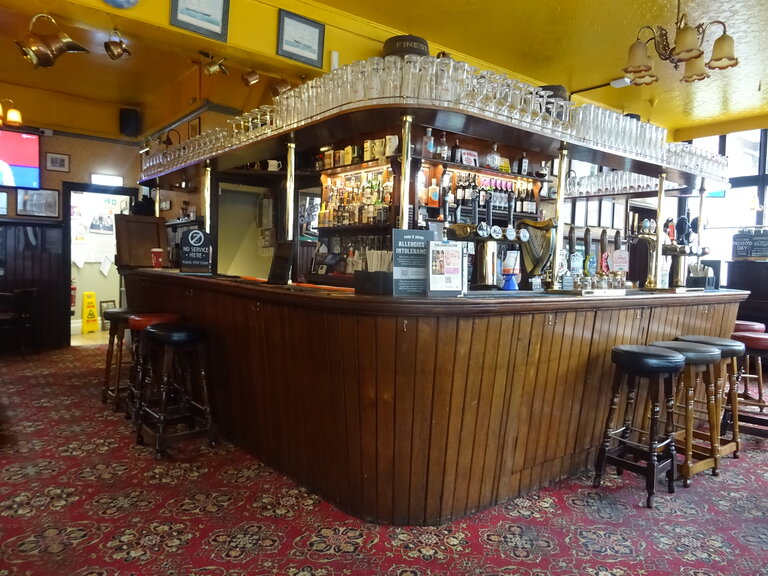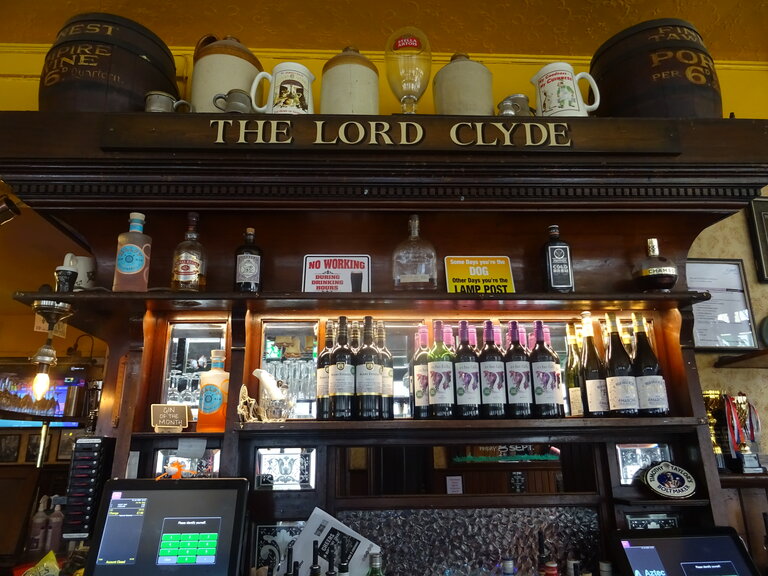Lord Clyde
27 Clennam StBorough,
SE1 1ER
This pub is not only a grade II listed building, it is also a Two Star pub on the Campaign for Real Ale’s (CAMRA) National Inventory with an interior of very special national historic interest, and the description is as follows: “In what must be the shortest street in London, the delightful Lord Clyde pub was rebuilt in 1913 and has a marvellous exterior with lots of ceramic work. Pride of place goes to a majestic eagle, the emblem of East End brewers, Truman, Hanbury and Buxton, while the fascia over the corner entrance bears the name ‘E J Bayling’ who must have been the owner and/or licensee on the eve of the Great War. Even the window surrounds are highly decorative. Inside, there are two rooms. The public bar (front) has a tapering, matchboarded counter and partly panelled walls. Note the fine mirror advertising ‘Mild Ales and Dublin Stout’. The back bar has a hatch to the servery and more wall panelling. A framed Truman’s price list tells us the prices of beer back in 1961. The fittings and detailing have a restraint and simplicity which forms a marked contrast to the ornateness of pubs from a decade or so before and gives a hint of what would come after the First World War.
History in a name: Colin Campbell Clyde was a distinguished Victorian commander who was granted a peerage in 1858 for his part in putting down the Indian Mutiny the previous year.
History in the area: The notorious debtors’ prison, the Marshalsea, was near Mermaid Court off Borough High Street. It was rebuilt on Borough High Street and opened in 1811. Charles Dickens’ father was imprisoned there and Dickens’ masterpieces David Copperfield and Little Dorrit both feature episodes set in the prison. It closed in 1842 after an Act of Parliament resulted in fewer people being imprisoned for debt. In 1849 most of the building was demolished but parts were converted in the 20th century and became a printworks. These, in turn, were demolished in the 1970s and replaced by two municipal buildings, the John Havard Library and the Local Studies Library.”
The listing description is as follows: “Public house of 1913, with minor late alterations.
MATERIALS: Constructed of red-brown English-bond brickwork, the façades are dominated by the glazed green and cream earthernware tiles that adorn the entirety of the ground floor, but also run in a continuous band below the main cornice, and in the window surrounds, on the pub sign to the chamfered corner, and around the oeil-de-boeuf first-floor window on the Clennam Street elevation. All brickwork to the ground floor is clad in green tiles as are the window surrounds and architraves, with the exception of the northern three bays on Ayres Street where the tiles are only used up to stallriser height. The flat roof, over all levels, is concealed behind a parapet.
PLAN: Of five bays to both the Clennam Street and Ayres Street elevations. The principal entrance (labelled 'Public Bar') is set within the heavily chamfered corner where the two streets meet. The Clennam Street elevation and returning two bays on Ayres Street are of three-storeys, plus cellar. The remaining three bays of this elevation are stepped, the next two being of two-storeys with the final bay being of a single storey. In addition to the principal entrance there are two secondary entrances on the Clennam Street elevation, the western of which is no longer in use, and a central one labelled 'Saloon Bar'. A service entrance is located in the northernmost bay of the Ayres Street elevation.
EXTERIOR: In addition to the tiling, windows dominate the ground floor. Above the approximately 1m high stallriser are a series of large single-pane, etched glass windows (many of which have been replaced), with a row of quarter-sized panels above along the entire Clennam Street elevation and first two bays of the Ayres Street elevation. A cream tile fascia runs above the ground-floor pub frontage with the words 'TRUMANS BURTON ALES THE LORD CLYDE TRUMANS LONDON STOUT E.J.BAYLING TRUMAN HANBURY BUXTON & CO LTD' highlighted in green tiles, under a heavy cornice.
On the upper floors, the sash windows are organized in pairs on each floor to Clennam Street and singly to Ayres Street, all in green tiled surrounds, most elaborately expressed in the oeil-de-boeuf. The tile band which runs below the cornice reads 'TRUMAN HANBURY BUXTON & CO LTD ALES STOUT & PORTER' highlighted in green tiles. A two-storey-high glazed tile plaque is mounted on the chamfered corner above the entrance at first and second storey levels. The cream tile background, surrounded by a green tile surround, bears the words 'THE / LORD CLYDE', under which is a raised relief of a black eagle with the words 'TRADE' and 'MARK' to either side and 'TRUMANS / BOTTLED / BEERS' below.
INTERIOR: Internally, there are two public rooms to the ground floor: one long and L-shaped, the other square, along with auxiliary rooms to the rear such as toilets and kitchen, both of which have been refurbished recently. Both the public rooms are panelled to dado-rail height. The bar and simple canopy, in similar wood to the panelling, are 'L' shaped, with a hatch for serving customers in the smaller room. There are original fireplaces in each bar, that to the main bar is decorated in glazed green tiles, matching the exterior. One of the original pub mirrors decorates the present-day bar. Two light-wells at ground floor level, light the rear corridor and kitchen and the main bar and ladies' toilets. The positioning of the blocked doorway and light-wells along with marks in the ceiling give some indication of the original layout. The basement has been altered since the pub was built but still contains a number of original panelled doors.
The upper storeys are given over to domestic accommodation, with a simple plan of four rooms per floor. All rooms, bar one, retain their original fireplaces, and some rooms retain picture-rails and gas lamp fittings. The stair has been encased with only the lower balusters being visible, these are of simple turned construction.
HISTORY: The Lord Clyde Public House was named after Field Marshall Colin Campbell Clyde (Lord Clyde) (1792-1863), a Scottish carpenter's son who joined the Army at 16 and rose to the rank of Commander in Chief. Educated at Glasgow High School and the Military Academy (Gosport) at the expense of his maternal uncle, an army Colonel called John Campbell, from whom Campbell adopted his surname, he fought many campaigns in the first half of the C19 and was raised to the peerage in 1858. Lord Clyde is buried in Westminster Abbey. The present-day pub sign shows Lord Clyde wearing the insignia of the Knight Commander of the Bath, an honour that he was awarded in 1849 for his services in the Sikh War.
The first Lord Clyde Public House was erected at the time of his death in 1863. The pub was rebuilt in 1913, and the present frontage dates from then, including the green and cream earthenware tiles. It was a new landlord, EJ Bayling, who undertook these works and he ensured his name appeared prominently beside that of the brewers, Truman's.
SOURCES: The Gazetteer for Scotland, Overview of Field Marshall Sir Colin Campbell http://www.geo.ed.ac.uk/scotgaz/people/famousfirst1206.html accessed 10 March 2010 British History on-line, Truman, Hanbury, Buxton and Company's Black Eagle Brewery, Brick Lane - From: 'The Black Eagle Brewery, Brick Lane', Survey of London: volume 27: Spitalfields and Mile End New Town (1957), pp. 116-122. http://www.british-history.ac.uk/report.aspx?compid=50162”
The WhatPub link is here: WhatPub/Lord Clyde
The Pub Heritage Group link is here PHG/Lord Clyde
The Lord Clyde featured on the Evening Crawl of the City of London and Borough on 2 August 2004, the Evening Crawl of Southwark on 16 August 2005, and the Princes' Progress: Evening Crawl of Kennington, Elephant & Castle, and Borough on 22 August 2012.





